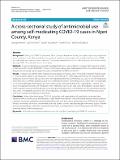| dc.contributor.author | Kimathi, George | |
| dc.date.accessioned | 2025-11-20T12:42:37Z | |
| dc.date.available | 2025-11-20T12:42:37Z | |
| dc.date.issued | 2022-08-30 | |
| dc.identifier.citation | Kimathi G, Kiarie J, Njarambah L, Onditi J, Ojakaa D. A cross-sectional study of antimicrobial use among self-medicating COVID-19 cases in Nyeri County, Kenya. Antimicrob Resist Infect Control. 2022 Aug 30;11(1):111. doi: 10.1186/s13756-022-01150-7. PMID: 36042483; PMCID: PMC9427085. | en_US |
| dc.identifier.uri | https://repository.amref.ac.ke/handle/20.500.14173/1101 | |
| dc.description.abstract | Background: During the COVID-19 pandemic, Nyeri County in Kenya was among the regions reporting a high number of confirmed cases. This exemplified the increased need of addressing potential antimicrobial resistance (AMR) and self-medication during disease outbreaks. This study examined the extent of self-medication with antimicrobials among COVID-19 confirmed cases in the County.
Methods: A cross-sectional survey using phone-based interviews was conducted in August 2021 among a sample of 280 out of 2317 confirmed COVID-19 cases in the County using a pre-coded questionnaire. Descriptive analyses of frequencies and causal logistic regression were conducted using STATA version 13.
Results: A total of 193 (68.9%) of the respondents indicated developing COVID-19 related symptoms-mainly cough (41.5%), headache (38.3%), and fatigue (34.7%). Over one-fifth (23.4%) of the respondents had self-medicated with antibiotics, 60.6% of whom did so at the onset of symptoms before the confirmatory test, and 51.5% self-medicating more than once. Common antibiotics used were Azithromycin (40.0%) and Amoxycilline (23.3%), with a considerable 21.7% having difficulty remembering the name of the drugs. Only half (50.4%) of the respondents (128/254) were aware of regulations towards self-medication with antibiotics. Age was the only socio-demographic variable significantly related to reduced self-medication, with older persons less likely to self-medicate. On the other hand, developing COVID-19 symptoms, awareness of COVID regulations, and appreciation of the need for self-medication awareness were related to increased self-medication.
Conclusion: Being older, developing COVID-19 symptoms, and appreciating self-medication awareness have influential effects on the use of antimicrobials. Public health interventions should be timely during infectious disease outbreaks to prevent undesirable health-seeking behavior such as irrational antimicrobial use. AMR policies should enhance awareness of the risks of self-medication and address barriers that deter people from timely access of health services during disease outbreaks. Further research should be conducted on the self-medication and AMR nexus, especially during health emergencies. | en_US |
| dc.language.iso | en | en_US |
| dc.publisher | Antimicrobial Resistance & Infection Control | en_US |
| dc.subject | Antimicrobial resistance; COVID-19 symptoms; Nyeri County Kenya; Self-medication; Survey. | en_US |
| dc.title | A cross-sectional study of antimicrobial use among self-medicating COVID-19 cases in Nyeri County, Kenya | en_US |
| dc.type | Article, Journal | en_US |

